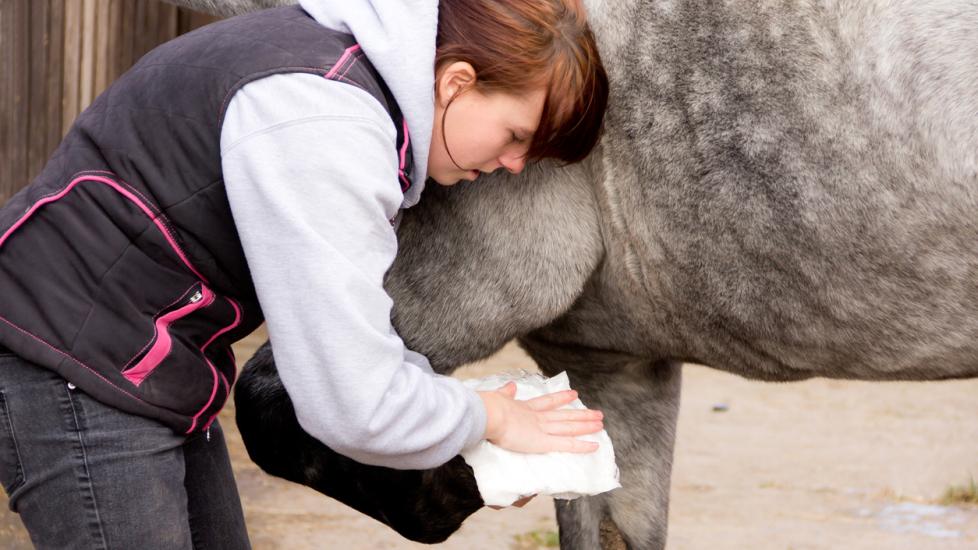How to Apply Poultice to a Horse
Horses are incredible athletes. Just like human athletes, they can get strains, sprains, and sore muscles. Poultices are a very common part of a horse owner’s bag of tricks to help with these mild exercise-related injuries. The legs and hooves are the most common places to use poultices on horses.
What Is a Poultice?
Poultices are thick, spreadable substances that are applied to the body and then covered with a bandage to keep them in place. The main purpose of a poultice is to act as a drawing agent. It can help to draw out heat, inflammation, and swelling, which are the three main consequences of exercise. By relieving these symptoms, poultices can help to start the healing process and prevent further injury.
Clay-based products and Epsom salt-based products are very common for poulticing the lower part of the limb. They help make the leg cool and tight after workouts and decrease the chances of sore muscles and swelling. Other additives such as witch hazel, arnica, and comfrey are commonly found in homemade and commercial poultices.
Hoof poultices often contain Epsom salts, ichthammol, or a mixture of sugar and betadine (sugardine). These poultices are typically used when a hoof abscess or bruise is suspected. They help to draw out bruising and infection.
When Should You Poultice a Horse's Leg?
Limb poultices are very useful after workouts and competitions. They are typically applied after the horse is fully cooled down and bathed. The poultice is then applied and left on overnight. Poulticing helps the horse’s limbs recover faster, which is especially important when a horse is competing over several days.
Hoof abscesses are a different scenario where poultices can be helpful. Usually, they are applied when the lameness is first noticed or has been diagnosed as a hoof abscess by the veterinarian. Hoof poultices should be repeatedly applied every 1-3 days, or as prescribed by your veterinarian, until the abscess resolves.
How Do You Put a Poultice on a Horse?
Poultices should be applied liberally and securely wrapped to be most effective. Materials that you may want to have for poulticing include:
-
Poultice of choice
-
Gauze pads or bandage strips
-
Elastikon
-
Diapers (for hoof wrapping)
-
Duct tape (for hoof wrapping)
The following are general instructions for applying most poultices to a horse’s limb; it is also important to follow the directions on the packaging of the product you have chosen. Additionally, horse owners inexperienced with poultices should consult with a veterinarian to ensure the poultice technique does not over-tighten the wrap.
-
Apply poultice of choice liberally to desired area.
-
Apply a thick layer of gauze padding/bandage over the entirety of the poulticed area, plus an additional inch on either end (this step is very important to help prevent over-tightening).
-
Apply vet wrap snuggly and evenly without over-tightening, leaving about an inch of gauze visible on either end.
-
Optional: Elastikon can be used to cap both ends of the bandage to prevent shavings or dirt from getting under the bandage. Lightly place half on the gauze and half on the skin. (NOTE: Elastikon is very easy to over-tighten and should NOT be stretched before or during application).
Poulticing hooves requires a slightly different process than the limbs, but many of the same concepts still apply.
-
Apply poultice of choice liberally to the sole and/or coronary band of the affected hoof. Alternatively, an Animalintex poultice pad can be soaked and applied to the sole for a less messy poultice experience.
-
Apply a thick layer of gauze padding/bandage or a diaper over the entirety of the poulticed area.
-
Apply vet wrap over the sole and hoof wall of the foot to secure the gauze and poultice in place. There is no concern for over-tightening on the hoof itself, but if any of the bandage extends over the coronary band, it is important to make sure that the wrapping remains loose in this area.
-
Create a square using overlapping strips of duct tape that is larger than your horse’s hoof print. Stick this directly to the bottom of your horse’s sole and use additional duct tape to flatten the edges and add extra durability to the bottom of your wrap.
-
Optional: Elastikon can be used to cap the end of the bandage around the coronary band/pastern to prevent shavings or dirt from getting under the bandage. Lightly place half on the gauze/vet wrap and half on the skin. (NOTE: Elastikon is very easy to over-tighten and should NOT be stretched before or during application).
Removal of Poultice
To remove a poultice from a horse, start by gently sweeping away and shavings, dirt, or other debris that may have accumulated on the bandage or wraps overnight. Underneath the wraps, the poultice will have dried completely. Gently brush away the dried clay-like substance with a brush or pair of grooming gloves.
Featured Image: iStock.com/Groomee
